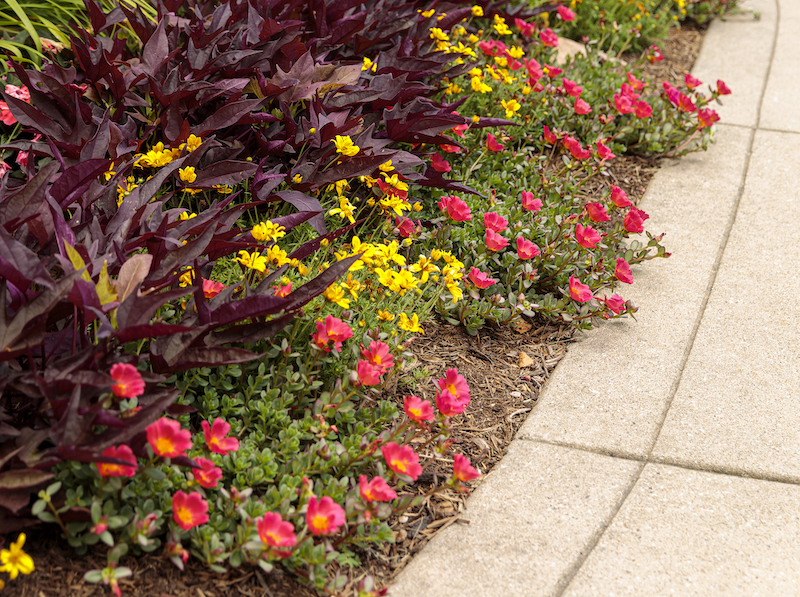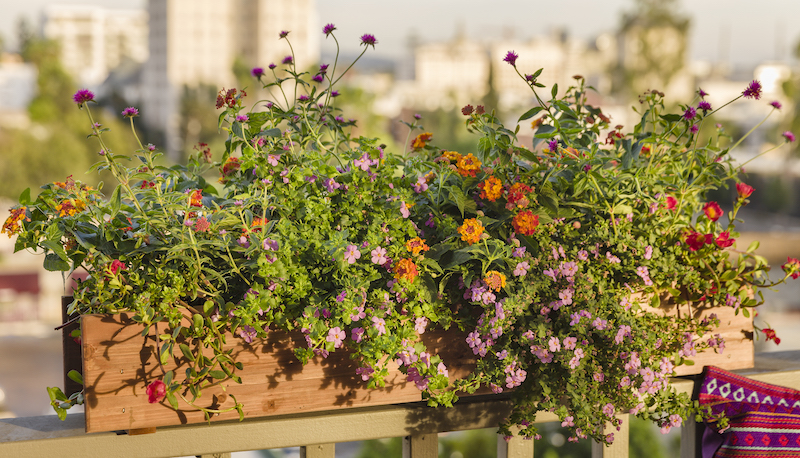Purslane or Portulaca is a flowering succulent that, while small, makes a substantial impact in a mixed bed, border, or container. The flowers are the main attraction for purslane. Abundant flowers in shades of red, pink, yellow, orange, or white have a slight ruffle to the petal, giving the flower some texture and providing a bold burst of color. Flowers bloom from spring through the end of summer for consistent color throughout the growing season.
Purslane reaches four to eight inches tall but can spread up to 16 inches across. This plant works well in a mixed bed as a ground cover or in a container where it fills and spills. Purslane goes well with hibiscus, sweetspire, butterfly bush, ice plant, coleus, and more.

Shrubs To Plant With Purslane
Hibiscus flowers have a similar appearance to purslane blooms, except they are larger. The petals of both flowers almost look like crepe paper and surround yellow stamens. Grow hibiscus in full sun, and water it regularly during dry weather. Hibiscus likes somewhat damp conditions, while purslane prefers drier soil. These plants can grow together in a mixed bed but give them some separation and plan to water the hibiscus more often.
Enjoy three seasons of color and texture with sweetspire. This bush features tiny flowers that have a feathery appearance and bloom in long, drooping clusters known as racemes. The green foliage turns vibrant shades of red during the fall. Sweetspire can live in partial to full sun but plant it in full sun when grown near purslane.
The butterfly bush has a similar appearance as sweetspire in terms of the flower clusters, so if you like the look of that shrub but want something smaller or want something that will bloom longer, consider a butterfly bush. Create a carpet-like ground cover using purslane around the base of a row of butterfly bushes.
Go with something unexpected by using purslane as a ground cover around atlas cedar or arborvitae. Both of these evergreens offer height and a lot of texture, which is an excellent background for the brilliant blooms and succulent foliage of purslane.
Perennials To Plant With Purslane
Purslane grows as a perennial in zones 10 through 11 but is often used as an annual in cooler areas. Ice plant is cold hardy and can live in zone 5 and above, but it shares the same growing preferences as purslane and makes a low-maintenance addition to a mixed perennial bed. Mix and match purslane with ice plants in a shared space. Both plants have a low, spreading growth habit and bold, textural flowers.
Add some height to a garden bed with lavender or catmint planted behind purslane for a tiered appearance. The purple flowers of lavender and catmint introduce different tones while still coordinating with purslane. Daylilies are another low-maintenance perennial that thrives in full sun and has low water needs, making them an excellent plant neighbor for purslane.

Annuals To Plant With Purslane
Verbena is another long-blooming plant that complements purslane. Plant annual verbena in full sun and give this plant room to spread. The flowers are about the same size but bloom in clusters, creating a larger scale.
Fiber optic grass gets its name from the tiny tufted flowers that bloom on the terminal ends of the long, willowy stems. While not an actual grass, fiber optic grass or Scirpus cernuus reaches about one foot tall and introduces a wispy texture to a planting. Both plants require full sun but feature purslane in front of fiber optic grass so that both plants can be admired.
Best Companion Plants For Purslane in Containers
Bacopa is a trailing annual that works as a filler in a container. This mounded plant is a prolific bloomer that sets flowers from spring through fall. Add purslane to the mix to create a vibrant hanging basket or container. Bacopa can grow in partial to full sun, but position it in a brighter spot when combined in a container with purslane.
Pair purslane with coleus so the brightly colored foliage will serve as a high contrast backdrop. Newer coleus cultivars (e.g. ColorBlaze® series) can handle full sun, so look for those. Too much direct sunlight will damage the foliage of older varieties, and purslane prefers bright sun.
Plants Not To Grow With Purslane
Purslane gets on well with other plants that have similar care needs. The only reason not to include certain plants with purslane is if the care requirements are too far apart. Moisture-craving plants like elephant ears and joe pye weed are not good companions for purslane, nor are shade-loving options like hosta and coral bells.
Best Plants To Grow With Purslane
Plants that need full sun and prefer dry conditions are a good match for purslane. Sweetspire, butterfly bush, daylilies, and bacopa all prefer similar conditions but also complement the good looks of purslane. Companion plants can have slightly differing care requirements, but take care to accommodate these needs when choosing the planting site.
 |
Author Alison Cotsonas - Published 10-12-2023 |
